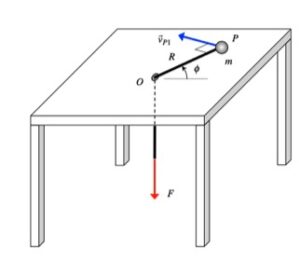| Problem statement Solution video |
DISCUSSION THREAD

NOTE: Please use F = 2000 N in this problem.
Any questions?? Please ask/answer questions regarding this homework problem through the "Leave a Comment" link above.
Discussion and hints
Recall the following four-step plan outline in the lecture book and discussed in lecture:
Step 1: FBDs
Draw a free body diagram of P.
Step 2: Kinetics (angular impulse/momentum and work/energy)
Note that all forces acting on P in the plane of the table point toward the fixed point O. What does this say about the angular momentum of P about point O? Also, consider the work/energy equation for P.
Step 3: Kinematics
The kinematics of P are best written in terms of polar coordinates R and φ.
Step 4: Solve
Solve for the R and φ components of velocity of P from these equations.
An important tip that can help when solving this problem is identifying the conditions in which angular momentum is conserved.
Since there is no friction between the rope and table, and the rope is flexible, can we assume that the tension on P from the rope is equal to F?
Yes, since there is no friction at the hole in the table, the tension in the cable is a constant value of F throughout.
There is no value for the angle phi. Do we not need the value of angle phi to solve this problem?
It is recommended that you write all of your vectors in terms of polar coordinates. With that, you do not need to know the angle phi.
If you use the polar kinematic velocity equation (which only has phi_dot), you can substitute it as v_p2 into the work energy and angular momentum equations.
Reminder that the force is acting in the negative r direction, so even if the r decreases, the force does positive work
The work done by the force is in the e_r direction entirely, if using polar coordinates. The velocity is perpendicular to that so I don't see how U in the W/E equation wouldn't go to 0.
nvm I figured it out- velocity has 2 components
Daniel: The velocity of P is perpendicular to e_R only for the initial instant in time. As P moves, it has both e_R and e_theta components. Keep in mind that the work term is an INTEGRATION over time, and is not based on a single instant in time.
I found it very helpful to recognize that the force is acting throughout the rope only in e_r. So keep this in mind when you apply the work-energy equation to find Rdot2 and phidot2. Where its helpful to seperate the equation in terms of e_r and e_theta.
I am struggling to solve for Rdot. Does anyone have any suggestions?
Charlotte: As discussed in lecture, the AIM equation cannot provide information on R_dot simply because that term gets lost when we take the cross product of r_P/O with v_P. Because of this, you need to have an alternate means to find R_dot. The work/energy equation can be used as that additional equation. This equation will provide you with an answer for v_P (the speed of P). Once you know v_P and once you find theta_dot from AIM, you can then solve for R_dot.
Would the numerical value of R_dot be a positive or negative value? I am getting a positive value mathematically, but intuitively it seems like it should be negative as the distance R is decreasing.
The work/energy equation will give you a value for R_dot^2. When you take the square root of that number, you actually have two roots: one positive and one negative. For the way this question is asked, the negative root makes sense. For later on in time, the particle will then change direction and move outward. For that position, you would choose the negative root.
Would there be potential energy at state 2? The mass itself is not changing height, but the force application point is. Does this only matter for work or would V_2 be mg(R_1 - R_2)?
The work done by F and the potential energy of P are two distinct quantities. Yes, F does work, and that goes into U. The gravitational potential of P is constant since it moves on a horizontal surface. If the potential did change, it would go into V. Two different things.
In the problem statement is says that F = 236N, but in the hints it says to use F = 2000N. Which one should we use when solving this problem?
The value of F here is a correction to the value given in the problem statement.
Is omega_dot supposed to be written as a vector in our answer?
I do not believe so as it asks for the numerical value.
When I conducted the solving process for omega_dot2, the two angular momentum equations I set equal to each other both had a unit vector k attached to them. As such, you can mathematically believe that the unit vectors divide out, allowing omega_dot2 to be written without a unit vector attached to it.
For finding R_dot2, that value is also without a unit vector attached as the work-energy equation used to find it involves scalars.